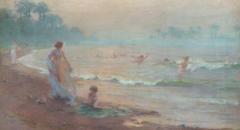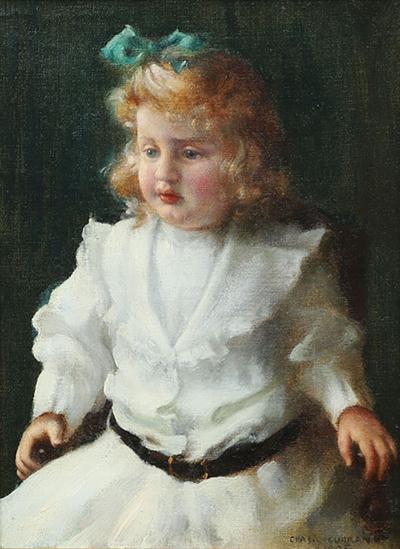Charles Courtney Curran
American, 1861 - 1942
Charles Courtney Curran (1861-1942) was a prominent American Impressionist celebrated for his elegant portrayals of women and children in natural settings. Known for his leadership at the Cragsmoor Art Colony, Curran’s work, often compared to that of Mary Cassatt and Frank Benson, features graceful figures adorned in flowing dresses against expansive landscapes.
Born in Hartford, Kentucky, Curran grew up in Sandusky, Ohio, and studied at the Cincinnati School of Design before moving to New York City in 1882. There, he studied at the National Academy of Design and the Art Students League. His artistic journey continued in Paris at the Académie Julian from 1889 to 1891, where he honed his impressionistic style.
After returning to the U.S., Curran became a central figure at the Cragsmoor Art Colony, where he painted idyllic scenes that encapsulated the beauty of summer. His technique involved loose brushstrokes and a vivid palette, capturing light and atmosphere in a way that brought his subjects to life.
In addition to his role in Cragsmoor, Curran taught at several institutions, including the Pratt Institute. He was an active member of numerous art societies and exhibited widely, with works housed in major collections such as the Metropolitan Museum of Art and the National Gallery of Art.
Curran's legacy endures through his enchanting paintings, which reflect both the charm of everyday life and the transformative power of nature.
Born in Hartford, Kentucky, Curran grew up in Sandusky, Ohio, and studied at the Cincinnati School of Design before moving to New York City in 1882. There, he studied at the National Academy of Design and the Art Students League. His artistic journey continued in Paris at the Académie Julian from 1889 to 1891, where he honed his impressionistic style.
After returning to the U.S., Curran became a central figure at the Cragsmoor Art Colony, where he painted idyllic scenes that encapsulated the beauty of summer. His technique involved loose brushstrokes and a vivid palette, capturing light and atmosphere in a way that brought his subjects to life.
In addition to his role in Cragsmoor, Curran taught at several institutions, including the Pratt Institute. He was an active member of numerous art societies and exhibited widely, with works housed in major collections such as the Metropolitan Museum of Art and the National Gallery of Art.
Curran's legacy endures through his enchanting paintings, which reflect both the charm of everyday life and the transformative power of nature.
